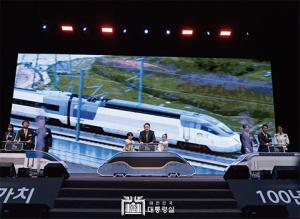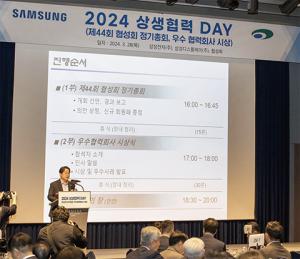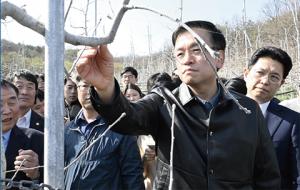 |
||
| ▲ Governor Hajin Song | ||
Seongyong Song (1913 ~ 1999) was a representative calligrapher and a Confucian scholar of Jeolla Province. While building his unique style in calligraphy, he proved his strong character by not changing his name as Japanese during the colonial era. Hajin Song, the Governor of North Jeolla Province, is a son of this great man. <Power Korea> met him.
Q. What kind of man was your father?
A. He spent his entire life as a calligrapher and a Confucian scholar. He was a man of straightforwardness and kept on wearing topknot and Korean dress and never changed his name against Japanese. For me however he was a man of diligence. Except when he went out, he always cleaned his room and the garden and studied until late night. He never lectured us or interfere what we were doing but was always benevolent. Looking back, his life itself was teaching.
Q. Jeolla Province celebrated 1,000th birthday last year?
A. The province was formed in 1018 during the years of King Hyeongjong of Goryeo and its people formed themselves voluntarily whenever the nation was in stake: the Japanese invasions of Korea in 1952, Donghak Peasant Revolution in 1894 and the Gwangju Uprising in 1980 to name a few. The province has been rich in traditional culture and food as we all know like Pansori (Korean musical storytelling) and Bibimbap (mixed rice with a variety of vegetables).
Q. Jeolla Province enjoyed the golden age of Korean agriculture.
A. Indeed! It always has been the field of gold like we often say ‘the breadbasket’. Talking of the golden age of the Korean agriculture, Jeonju City once was the largest provincial city that ruled both North and South Jeolla provinces and as far down as to Jeju Island during the Joseon dynasty alongside Hanyang (Seoul) in the South and Pyongyang in the North. 1960 was the beginning year of the Five-Year Plans (economic development plan introduced by the former president Chunghee Park) and also the year of deteriorating the golden age of Korean agriculture as the industrial plans laid heavily in Gyeongsang Province. And it is till leaving Jeolla Province behind of its eastern counterpart in terms of economy. The good news however is the rich cultural assets we have accumulated and our plan to converge these excellent resources with cutting edge technologies to fly once more.
Q. Korea National College of Agriculture and Fisheries has moved to North Jeolla Province?
A. Opened in 1997, it relocated to the current area in 2015. The 18 majors in 6 areas (crop, horticulture, forestry, stockbreeding, fisheries and convergence) are being heated up with passions of 550 future industry specialists. The Rural Development Administration and its affiliates are also located in the region and they are creating synergy effect. What is more, Jeolla Province is the very place where the Moon Administration’s pledges ‘Asia Smart Agricultural Valley’ and ‘Bio-Agricultural Innovation Cluster’ is happening.
Q. Tell me about the Korea National Food Cluster in Iksan City.
A. The complex was completed March this year. 25 out of total 72 in-house factories are running at the moment and the rests are expected to be in full force within this year. The subsidy for land purchase fee and the plant and equipment investment are provided for companies in the capital region wishing to relocate to the area. The R&D center, resource center and food shape technology center will also be providing support for the in-house companies. The government’s goal, however, is far bigger than this: it is to grow the Korea National Food Cluster as the leader of food markets in the Northeast Asian region where around 1.5 billion people are living.
Q. What will become of GM in Gunsan City?
A. It is good news that the Korean MS Autotech signed with GM Korea for overtaking the business within 10 months after closure of the Gunsan factory. All procedures including the ownership will be done by the end of June followed by installment of electric vehicle facilities and recruitment which will see its full running by 2021. The overtaking is expected to improve the structure of the Korean car industry and MS Autotech is ambitious to produce 50,000 units of electric vehicles at the initial stage but around 150,000 around 2025. This means that it will create around 2,000 jobs in the region.
Q. Saemangeum International Airport is to be built.
A. A preliminary feasibility study is being carried on at the moment and it will take around 10 years to build. If the feasibility study is passed, the details of location, scale and budget will be brought in and the construction then will start around 2020. It is important to know that building Saemangeum International Airport is part of the government’s balanced development of the nation. *Saemangeum is an estuarine tidal flat.
Q. Tell me about the Saemangeum New Renewable Energy Cluster.
A. It is a government project to build the world’s largest solar energy complex within the Saemangeum area and wind power complex around the Gunsan area. When completed, both will generate energy same as four 1GW level nuclear power plants. It is encouraging that many related companies are always showing their interest in the project and an on-the-water solar power company has started to build its factory in Saemangeum since March this year.
Q. What is Saemangeum Korea 2023?
A. The Saemangeum Korea 2023 is the 25th World Scout Jamboree Candidate. The hosting of this international event will boost up the landfill and the construction of the infrastructure such as harbors and airport in the area. The Saemangeum Korea 2023 will invite 50,000 youths from 169 countries and they will be wowed by the Korea’s cutting technologies alongside unique nature and rich cultural assets.
Q. Lastly, what would like to achieve during your term as the governor?
A. I’ve worked as an administrator for the last 40 years. All those years, I’ve dreamed of bringing back the golden age of Korean agriculture to the province one more time. And I found the answer always has been in us and it is to make the most of what we have achieved and what we have accumulated and what we are good at rather than to pursue what others are doing or good at. Jeolla Province will create landmarks in bio-agriculture, carbon industry, and future-oriented convergence industry as well as ecology and cultural assets. And the number of Saemangeum projects will lay a great foundation for this on which we will make our dream come true in near future.
송방원 기자 songbw69@naver.com







